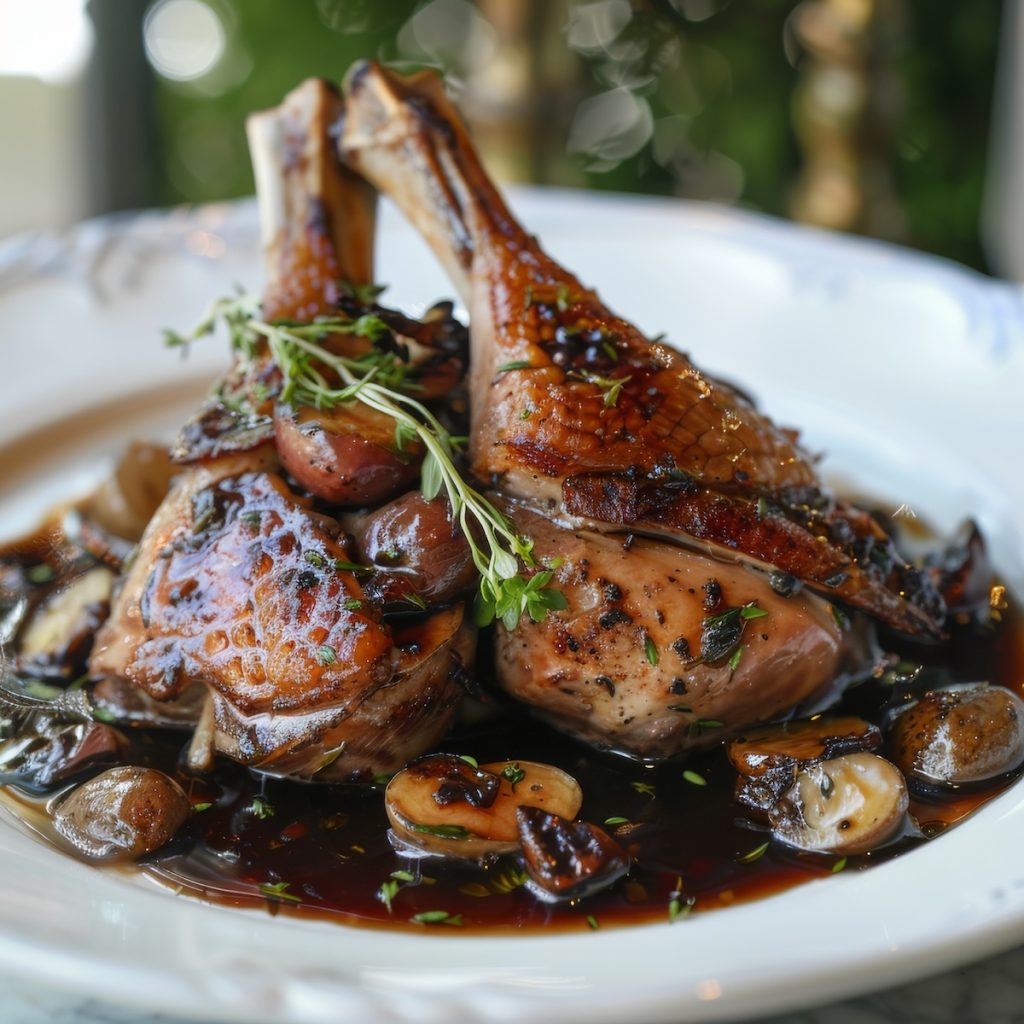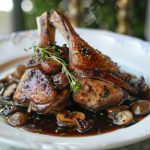Pan Roasting a Rabbit Is Easier Than You Think
Pan-roasting rabbit is an elegant and rustic method that brings out the natural flavors of this tender and lean meat. Often overlooked in modern kitchens, rabbit is a versatile protein celebrated in many traditional European cuisines, particularly in the Mediterranean and French countryside. Its delicate flavor is often compared to chicken but with a slightly sweeter and earthier profile, making it a delightful option for those looking to expand their culinary repertoire.
This recipe embraces the simplicity of pan-roasting, a technique that allows for even cooking while achieving a beautifully caramelized exterior. Combining aromatics like garlic, rosemary, and thyme with a touch of white wine and broth makes the rabbit moist and flavorful, resulting in a comforting and refined dish.
Perfect for a special occasion or a weekend dinner, pan-roasting rabbit offers a unique way to elevate your cooking while staying true to timeless culinary traditions. Whether you’re new to cooking rabbit or a seasoned enthusiast, this recipe will guide you through creating a meal that will impress your guests and awaken your taste buds to something extraordinary.
About Eating Rabbit
The history of eating rabbits dates back thousands of years, with evidence showing that wild rabbits were hunted and consumed by prehistoric people. Native to the Iberian Peninsula and parts of North Africa, rabbits were highly prized for their lean meat and prolific breeding habits, making them a reliable food source in ancient societies.
The Romans were among the earliest to domesticate rabbits, keeping them in walled enclosures called leporaria for easy hunting and consumption. This practice spread throughout the Roman Empire, and rabbits became a popular dish across Europe.
In medieval times, rabbit meat was considered an essential part of the diet in monasteries, mainly because it was classified as “fish” and permitted to be eaten during Lent.
Rabbit has long been a staple in Mediterranean and French cuisine, often featured in stews, roasts, and rustic countryside dishes. In France, dishes like lapin à la moutarde (rabbit with mustard) became renowned, while in Spain, rabbit is often used in paella.
In the Americas, indigenous peoples consumed rabbits, and their popularity continued among early settlers. While rabbit consumption diminished in the 20th century in some places, it remains a celebrated and sustainable choice in traditional and modern cuisine.
What Does Rabbit Taste Like?
Rabbit meat has a mild, slightly sweet flavor, often compared to chicken, but with a more nuanced, earthy undertone. The texture is lean and tender, with a fine grain that makes it versatile in various cooking methods. Due to its leanness, rabbits can dry out quickly if overcooked, so they benefit from slow cooking techniques like braising, careful roasting, or pan-searing.
There are subtle flavor differences between wild and farm-raised rabbits. Wild rabbit tends to have a more intense, gamey flavor, reflecting its natural diet, while farm-raised rabbit is generally milder and more consistent in taste. The meat absorbs flavors well, making it an excellent canvas for herbs, spices, and sauces.
Rabbit offers a delicate yet distinctive flavor that works beautifully in stews, roasts, and lighter dishes, making it a versatile choice for rustic and refined cooking.
Where Do You Buy Rabbit?
Rabbit meat found in supermarkets typically comes from domesticated rabbits raised on farms. These rabbits are bred specifically for meat production, often in controlled environments to ensure consistent quality and taste. The most common breed used for commercial rabbit meat is the New Zealand White, known for its fast growth rate, tender meat, and good meat-to-bone ratio.
Rabbit farms are often located in regions with established meat production industries, such as the United States, Europe (mainly France, Spain, and Italy), and China, the largest rabbit meat producer globally. In the U.S., many rabbit farms are small-scale or family-owned operations, and the rabbits are raised in conditions designed to be humane and sustainable.
Farm-raised rabbits are fed a diet of hay, grains, and vegetables, resulting in a mild, consistent flavor compared to their wild counterparts. The meat is processed under regulated conditions to ensure safety and quality before being packaged and distributed to supermarkets.
Supermarket rabbits are usually sold whole or in portions, such as legs or loins, and can often be found frozen or fresh, depending on the store’s selection.
Rabbit Labling
Rabbit meat in supermarkets is typically labeled with the following descriptions:
- Whole Rabbit: The rabbit is cleaned and prepared for roasting or stewing. Usually, it includes the head and organs, though some may be removed.
- Rabbit Legs: Two or four legs, often sold as a pair. These cuts are popular for braising or slow cooking, as they are flavorful and tender.
- Rabbit Loins are the back portion of the rabbit. They offer tender, boneless meat and are ideal for grilling, pan-searing, or roasting.
- Rabbit Saddles: The central portion of the rabbit, including the loins and ribs. A premium cut, often used for roasting or stuffing.
- Rabbit Pieces: Mixed cuts, typically including legs, loins, and other parts. This option is versatile and great for stews or casseroles.
Rabbit meat is also labeled by weight and age, which can influence the meat’s tenderness and flavor. Here are the typical labels:
- Fryer Rabbit (2.5 to 3.5 pounds): This label indicates a younger rabbit, usually around 8 to 12 weeks old. Fryer rabbits have tender meat, making them ideal for quick cooking methods like frying, roasting, or grilling.
- Roaster Rabbit (4 pounds and up): Roaster rabbits are older, typically between 12 weeks and six months old. They have slightly firmer meat with a more developed flavor, making them suitable for slower cooking methods like braising or stewing.
- Young Rabbit: This label generally refers to a rabbit under 6 months old. It offers a balance of tenderness and flavor and can be used for a variety of cooking methods.
- Mature Rabbit: This refers to rabbits that are over six months old. The meat is firmer and has a more robust flavor, making it ideal for slow-cooked dishes like stews or casseroles, where long cooking times help to tenderize the meat.
The rabbit’s weight is usually indicated on the packaging, and these age-related labels help guide consumers on the best cooking techniques.
Pan Roasted Rabbit Recipe with Garlic and Herbs
Ingredients
- 1 whole rabbit cut into pieces (legs, loins, saddle)
- salt and pepper to taste
- 2 tablespoons olive oil
- 4 cloves garlic crushed
- 1 small onion finely chopped
- 2 sprigs fresh rosemary
- 2 springs fresh thyme
- 1 cup white wine
- 1 cup chicken broth
- 2 tablespoons
- juice of 1 lemon
- fresh parsley chopped for garnish
Instructions
Prepare the Rabbit
- Season the rabbit pieces generously with salt and pepper. Let them sit at room temperature for 15-20 minutes.
Sear the Rabbit
- Heat olive oil in a large, heavy skillet over medium-high heat. When the oil is hot, add the rabbit pieces, making sure not to overcrowd the pan. Sear the rabbit until golden brown on all sides, about 4-5 minutes per side. Remove the rabbit from the skillet and set aside.
Sauté Aromatics
- In the same skillet, lower the heat to medium. Add the crushed garlic and chopped onion. Sauté until fragrant and softened, about 3 minutes.
Add Herbs and Liquids
- Add the rosemary and thyme sprigs to the skillet, followed by the white wine. Let the wine simmer for 2-3 minutes, scraping up any browned bits from the bottom of the pan. Add the chicken broth and bring to a gentle simmer.
Cook the Rabbit
- Return the rabbit pieces to the skillet, nestling them into the sauce. Cover the skillet and let the rabbit cook over medium-low heat for 20-25 minutes or until the meat is tender and cooked through.
Finish the Sauce
- Remove the rabbit from the skillet and keep warm. Discard the herb sprigs. Increase the heat and let the sauce reduce slightly. Stir in the butter and lemon juice, and adjust the seasoning with salt and pepper if needed.
Serve
- Place the rabbit pieces on a serving platter and spoon the sauce over the top. Garnish with fresh parsley. Serve with roasted vegetables, mashed potatoes, or crusty bread.
Notes
- Marinate the rabbit in olive oil, garlic, and herbs for a few hours before cooking for extra flavor.
- Be careful not to overcook the rabbit, as it can become dry. Aim for tender, juicy meat.









8 Responses
This looks delish, can’t wait to try it. Wow.
Where to find pomegranate Port reduction? Do you make it yourself, or it be purchased. Thanks. AD. Your dish sounds good, I am almost tasting it. Although I would use more spices.
Hi Annette, you can find this Pomegranate Port reduction at clubsauce.com. Just tell Jules, The Reluctant Gourmet sent you. – RG
Made this for Easter dinner tonight with a rabbit I purchased on a whim at our farmer’s market. Although I didn’t have all the correct ingredients – made quite a few substitutions for the sauce – it still came out wonderfully. Even my very picky hubby concurred. Can’t wait to try it again as written
I would like to make this but I cannot find anywhere in the recipe that lists the ingredients for the sauce (e.g. quantities of Craisins) and clubsauce has not answered. Figured I could use Tamarind Molasses and port but quantities would sure help …
Hi Laura, thank you for contacting me about ingredients and quantities. As I mentioned in the beginning of the post, my friend David and I kind of winged it and were using a little of this and a little of that but I did go back and add some quantities that I would use if making this dish. I often use recipes as starts and make adjustments along the way based on personal preferences, what I have on hand and what makes sense to me. I too appreciate knowing the exact amounts when preparing a new recipe but I think experimenting with new products and ideas is also a good way to improve my skills.
As for the Pomegranate Reduction Sauce – Splash, it’s no longer available. I think your Tamarind Molasses would be a great substitute. I edited this recipe and suggest trying a pomegranate syrup that’s available at most supermarkets.
Thanks again for letting me know, RG
How long do you pan fry it. Since it will also bake in the oven. Concerned about overcooking it. Is it just a sear or do you cook it. I appreciate your letting me know.
Thanks!
Just a sear Lilly. You just want to brown it on the outside and finish in the oven to desired temperature.
Should I soak the rabbit meat in a salt brine over night prior to cooking ?